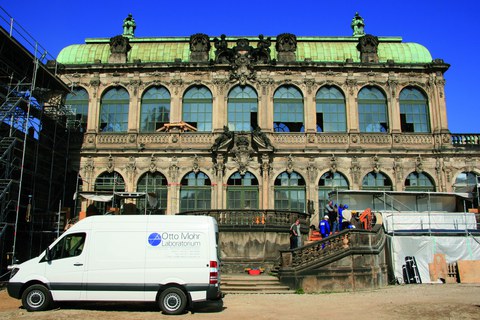Structural safety of a historic balustrade made of sandstone
Table of contents
Project data
| Titel | Title Tragsicherheit einer historischen Sandsteinbalustrade | Structural safety of a historic balustrade made of sandstone Auftraggeber | Client Staatsbetrieb Sächsisches Immobilien- und Baumanagement (SIB), Niederlassung Dresden I Zeitraum | Period 09.2010 Leiter | Project Manager Dr.-Ing. Torsten Hampel Durchführende | Project Executors Ludwig Beier, Tino Jänke, Christian Dittrich Projektpartner | Project Partners Ingenieurgesellschaft Hochbau GbR, Dresden |
Report in the yearbook 2010
Historic sandstone balustrade holds

Mathematical-physical salon in the Dresden Zwinger, on the right in the picture the balustrade to be examined
The Mathematical-Physical Salon on the west side of the Dresden Zwinger is currently being remodeled. This includes an open staircase lined with balustrades, which is to be opened to the public. However, the load-bearing capacity verification
was problematic, mainly due to the difficult geometry and the construction details and material properties that are difficult to describe from a structural point of view, which is why an on-site load test was to provide clarity.
The horizontal line load to be verified mathematically can only be realized with difficulty in in-situ tests. Therefore, three balustrade sections of equal length should each be loaded centrally by equivalent point loads. The safety factor with respect to the characteristic load according to the standard was set at 2.25 and the transition from elastic to plastic deformations was specified as the failure criterion, since the destruction of the balustrade was to be excluded. Plastic deformations would occur in the case of cracks in the horizontal joints, in the case of sandstone spalling or when the horizontal and vertical steel components, which are located on the inside in places, start to flow. The real-time display of the deformations on the measuring computer during the test allows the critical point to be determined precisely.
The concentrated loads were applied with synchronized hydraulic presses and downstream load cells via three decoupled load frames wedged on both sides of the staircase. Two inductive displacement transducers (IWA) per frame recorded the deformations at handrail height and at the base of the most stressed sandstone column, and a third IWA recorded the deformation of the abutment wall on the inside of the staircase.
The ultimate load test was successfully performed on September 22, 2010. The target load was safely achieved. With an additional loading step carried out at short notice, a safety factor of 2.5 was even verified. The deformations were mostly in the reversible, elastic range. During the last load cycle, a noticeable increase in the plastic portions was registered, of which a maximum of 1.5 mm was irreversible and manifested itself in the form of non-critical hairline cracks. For a structurally identical balustrade, a safety factor of at least 3.0 is probable when the existing built-in parts are taken into account, even if noticeable deformations would occur due to the activation of the metal built-in parts.
